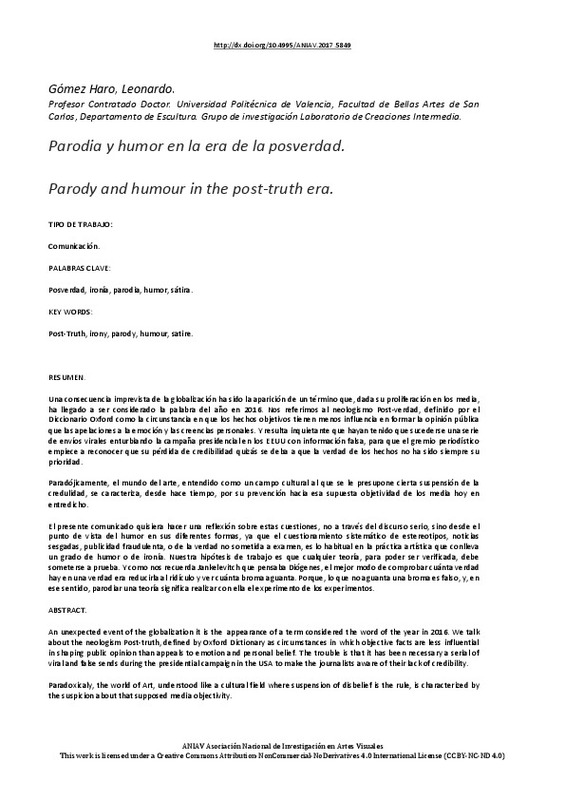JavaScript is disabled for your browser. Some features of this site may not work without it.
Buscar en RiuNet
Listar
Mi cuenta
Estadísticas
Ayuda RiuNet
Admin. UPV
Parodia y humor en la era de las posverdad
Mostrar el registro sencillo del ítem
Ficheros en el ítem
| dc.contributor.author | Gómez Haro, Leonardo
|
es_ES |
| dc.date.accessioned | 2018-09-10T08:47:42Z | |
| dc.date.available | 2018-09-10T08:47:42Z | |
| dc.date.issued | 2017-10-23 | |
| dc.identifier.isbn | 9788490485736 | |
| dc.identifier.uri | http://hdl.handle.net/10251/106845 | |
| dc.description.abstract | [EN] An unexpected event of the globalization it is the appearance of a term considered the word of the year in 2016. We talk about the neologism PostTtruth, defined by Oxford Dictionary as circumstances in which objective facts are less influential in shaping public opinion than appeals to emotion and personal belief. The trouble is that it has been necessary a serial of viral and false sends during the presidential campaign in the USA to make the journalists aware of their lack of credibility. Paradoxicaly, the world of Art, understood like a cultural field where suspension of disbelief is the rule, is characterized by the suspicion about that supposed media objectivity. The present statement wants to reflect about this topic, from the humour point of view in its different ways, as the systematic questioning of stereotypes, biased news, fraudulent advertisement, or the non checked truth, is the usual way in the artistic practice that involves irony and humour. Our hypothesis it is that any theory to be verified, needs to be proved. Jankelevitch and Diogenes remind us that the best way to prove how many truth there is in a Truth is to reduced it to ridiculous, and seeing how many jokes it is able to take. Because as far as something that doesn’t take a joke is false, the parody of a theory is to do with it the check of the checks. | es_ES |
| dc.description.abstract | [ES] Una consecuencia imprevista de la globalización ha sido la aparición de un término que, dada su proliferación en los media, ha llegado a ser considerado la palabra del año en 2016. Nos referimos al neologismo Post-verdad, definido por el Diccionario Oxford como la circunstancia en que los hechos objetivos tienen menos influencia en formar la opinión pública que las apelaciones a la emoción y las creencias personales. Y resulta inquietante que hayan tenido que sucederse una serie de envíos virales enturbiando la campaña presidencial en los EEUU con información falsa, para que el gremio periodístico empiece a reconocer que su pérdida de credibilidad quizás se deba a que la verdad de los hechos no ha sido siempre su prioridad. Paradójicamente, el mundo del arte, entendido como un campo cultural al que se le presupone cierta suspensión de la credulidad, se caracteriza, desde hace tiempo, por su prevención hacia esa supuesta objetividad de los media hoy en entredicho. El presente comunicado quisiera hacer una reflexión sobre estas cuestiones, no a través del discurso serio, sino desde el punto de vista del humor en sus diferentes formas, ya que el cuestionamiento sistemático de estereotipos, noticias sesgadas, publicidad fraudulenta, o de la verdad no sometida a examen, es lo habitual en la práctica artística que conlleva un grado de humor o de ironía. Nuestra hipótesis de trabajo es que cualquier teoría, para poder ser verificada, debe someterse a prueba. Y como nos recuerda Jankelevitch que pensaba Diógenes, el mejor modo de comprobar cuánta verdad hay en una verdad era reducirla al ridículo y ver cuánta broma aguanta. Porque, lo que no aguanta una broma es falso, y, en ese sentido, parodiar una teoría significa realizar con ella el experimento de los experimentos. | es_ES |
| dc.format.extent | 5 | es_ES |
| dc.language | Español | es_ES |
| dc.publisher | Editorial Universitat Politècnica de València | es_ES |
| dc.relation.ispartof | Glocal [codificar, mediar, transformar, vivir] III Congreso Internacional de Investigación en Artes Visuales | es_ES |
| dc.rights | Reconocimiento - No comercial - Sin obra derivada (by-nc-nd) | es_ES |
| dc.subject | Posverdad | es_ES |
| dc.subject | Ironía | es_ES |
| dc.subject | Humor | es_ES |
| dc.subject | Sátira | es_ES |
| dc.subject | Post-truth | es_ES |
| dc.subject | Irony | es_ES |
| dc.subject | Parody | es_ES |
| dc.subject | Humour | es_ES |
| dc.subject | Satire | es_ES |
| dc.subject.classification | ESCULTURA | es_ES |
| dc.title | Parodia y humor en la era de las posverdad | es_ES |
| dc.title.alternative | Parody and humour in the post-truth era | es_ES |
| dc.type | Capítulo de libro | es_ES |
| dc.type | Comunicación en congreso | es_ES |
| dc.identifier.doi | 10.4995/ANIAV.2017.5849 | |
| dc.rights.accessRights | Abierto | es_ES |
| dc.contributor.affiliation | Universitat Politècnica de València. Departamento de Escultura - Departament d'Escultura | es_ES |
| dc.contributor.affiliation | Universitat Politècnica de València. Facultad de Bellas Artes - Facultat de Belles Arts | es_ES |
| dc.description.bibliographicCitation | Gómez Haro, L. (2017). Parodia y humor en la era de las posverdad. En Glocal [codificar, mediar, transformar, vivir] III Congreso Internacional de Investigación en Artes Visuales. Editorial Universitat Politècnica de València. 303-307. https://doi.org/10.4995/ANIAV.2017.5849 | es_ES |
| dc.description.accrualMethod | OCS | es_ES |
| dc.relation.conferencename | III Congreso Internacional de Investigación en Artes Visuales :: ANIAV 2017 :: GLOCAL | es_ES |
| dc.relation.conferencedate | Julio 06-07,2017 | es_ES |
| dc.relation.conferenceplace | Valencia, Spain | es_ES |
| dc.relation.publisherversion | http://ocs.editorial.upv.es/index.php/ANIAV/ANIAV2017/paper/view/5849 | es_ES |
| dc.description.upvformatpinicio | 303 | es_ES |
| dc.description.upvformatpfin | 307 | es_ES |
| dc.type.version | info:eu-repo/semantics/publishedVersion | es_ES |
| dc.relation.pasarela | OCS\5849 | es_ES |








